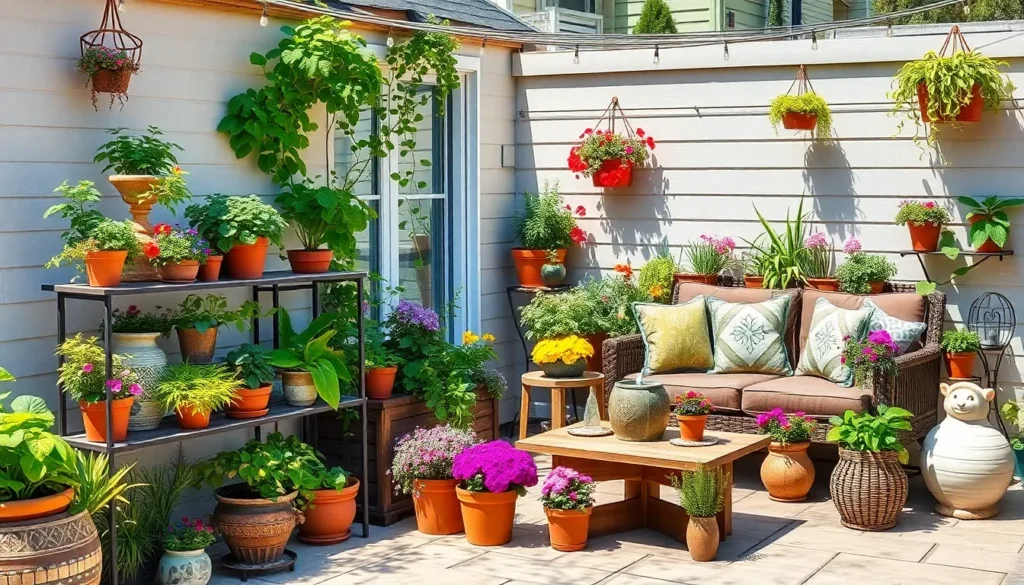Transform your outdoor space into a thriving green oasis with creative patio garden ideas that’ll make your neighbors envious. Whether you’re working with a tiny balcony or a spacious deck, we’ve discovered countless ways to maximize every square inch while creating a stunning retreat right outside your door.
Patio gardening isn’t just about throwing a few pots together and hoping for the best. We’re talking about strategic design choices that blend functionality with beauty – from vertical growing systems that climb your walls to clever container arrangements that create depth and visual interest. The best part? You don’t need a sprawling backyard to grow fresh herbs, colorful flowers, or even vegetables.
We’ll show you how to turn any patio into a productive garden paradise using smart space-saving techniques and plant selections that thrive in containers. Get ready to discover inspiring ideas that’ll transform your outdoor living space into the garden retreat you’ve always dreamed of having.
Start With Container Gardening Basics
Container gardening forms the foundation of any successful patio garden design. We’ll explore the essential elements that ensure your containers support healthy plant growth while complementing your outdoor space.
Choose the Right Size Containers
Large containers work best for most patio gardens because they provide adequate root space and retain moisture longer than smaller pots. We recommend containers that are at least 12 inches deep for herbs and leafy greens, while tomatoes and peppers need containers measuring 18 to 24 inches deep.
Wide containers offer more planting space than tall narrow ones, allowing you to grow multiple plants together or create stunning arrangements. Rectangular planters measuring 24 inches long by 12 inches wide can accommodate three to four herb plants comfortably. Round containers with diameters of 16 to 20 inches work perfectly for single large plants like dwarf fruit trees or substantial vegetable plants.
Small containers limit plant options but they’re perfect for compact herbs like thyme, oregano, and chives. These 6 to 8 inch pots fit easily on narrow patio railings or small side tables where space is premium.
Select Proper Drainage Systems
Drainage holes prevent root rot by allowing excess water to escape from container bottoms. We always ensure our containers have multiple holes that are at least half an inch in diameter, spacing them every 4 to 6 inches across the bottom surface.
Drainage layers improve water flow through the soil and prevent holes from becoming clogged. Add 2 to 3 inches of coarse materials like broken pottery pieces, pebbles, or expanded clay pellets before adding potting soil. This creates a reservoir that keeps roots from sitting in stagnant water.
Elevated containers enhance drainage while protecting patio surfaces from water stains. Plant caddies with wheels, decorative pot feet, or simple wooden blocks raise containers 2 to 4 inches off the ground and allow air circulation underneath.
Pick Weather Resistant Materials
Ceramic and terracotta containers offer classic appeal but they can crack during freeze thaw cycles in colder climates. We choose high fired ceramic or glazed terracotta pieces that withstand temperature fluctuations better than standard clay pots. These materials also provide excellent insulation for plant roots.
Resin and composite containers resist weather damage while mimicking the appearance of stone, wood, or ceramic at a fraction of the weight. Modern resin planters withstand UV rays without fading and they won’t crack in freezing temperatures. Many composite options include built in water reservoirs for consistent moisture levels.
Wood containers require proper treatment to resist moisture damage and insect problems. Cedar and redwood naturally resist decay, while pressure treated lumber needs food safe sealers if you’re growing edible plants. Metal containers like galvanized steel or aluminum resist rust and provide contemporary styling, though they may require insulation in extreme temperatures to protect plant roots.
Create Vertical Growing Spaces
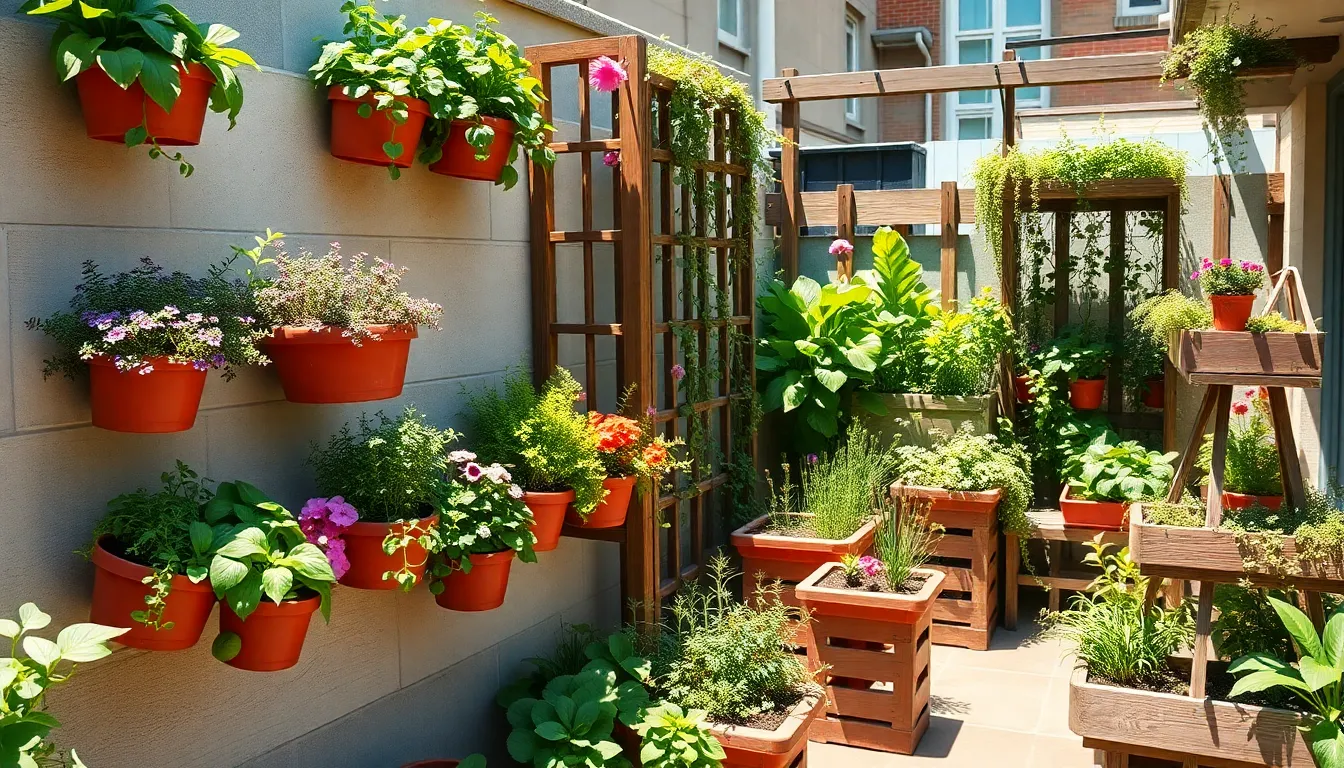
We can transform our patio into a thriving garden paradise by growing upward instead of outward. Vertical gardening maximizes every square inch of available space while creating stunning visual displays that turn walls and corners into productive growing areas.
Install Wall-Mounted Planters
Wall-mounted planters offer the perfect solution for freeing up valuable floor space while keeping our plants at eye level for easy maintenance. We can attach these versatile containers to fences, railings, or exterior walls using metal brackets or mounting hardware designed for our exact wall type.
Metal planters provide excellent durability and modern aesthetics, while plastic options offer lightweight convenience for renters who need removable answers. Wood planters blend naturally with outdoor decor and can be stained or painted to match our patio’s color scheme.
Modular wall-mounted systems allow us to rearrange our garden layout seasonally or as our plant collection grows. We can start with herbs like basil, oregano, and thyme in upper planters, then add flowering plants like petunias or marigolds in lower positions for cascading color effects.
Use Trellises for Climbing Plants
Trellises transform vertical surfaces into productive growing zones while providing essential support for vining plants. We can grow tomatoes, peas, beans, and cucumber varieties that naturally climb upward, maximizing our harvest in minimal floor space.
Standalone trellis structures work perfectly in corners or against blank walls, while integrated designs can be built directly into our vertical garden systems. Flowering vines like clematis, morning glories, and sweet peas add beautiful color and fragrance while screening unsightly areas.
Proper trellis placement improves air circulation around our plants, reducing disease risk and promoting healthier growth. We should position trellises where climbing plants can receive adequate sunlight throughout the day while having room to spread their foliage.
Build Tiered Plant Stands
Tiered plant stands create multiple growing levels within a compact footprint, allowing us to display diverse plant species at varying heights. We can purchase ready-made stands or construct custom answers using shelves, cinder blocks, or step-like wooden structures.
Three to four tier systems work best for most patio spaces, providing enough vertical interest without overwhelming smaller areas. We can place taller plants like small fruit trees or large herbs on lower tiers, with cascading plants like trailing strawberries or ivy on upper levels.
DIY tiered stands using reclaimed wood or metal shelving offer budget-friendly options while allowing us to customize dimensions for our exact space requirements. These stands make watering and harvesting more convenient by bringing plants to comfortable working heights, especially beneficial for seniors or those with mobility considerations.
Design Theme-Based Garden Sections
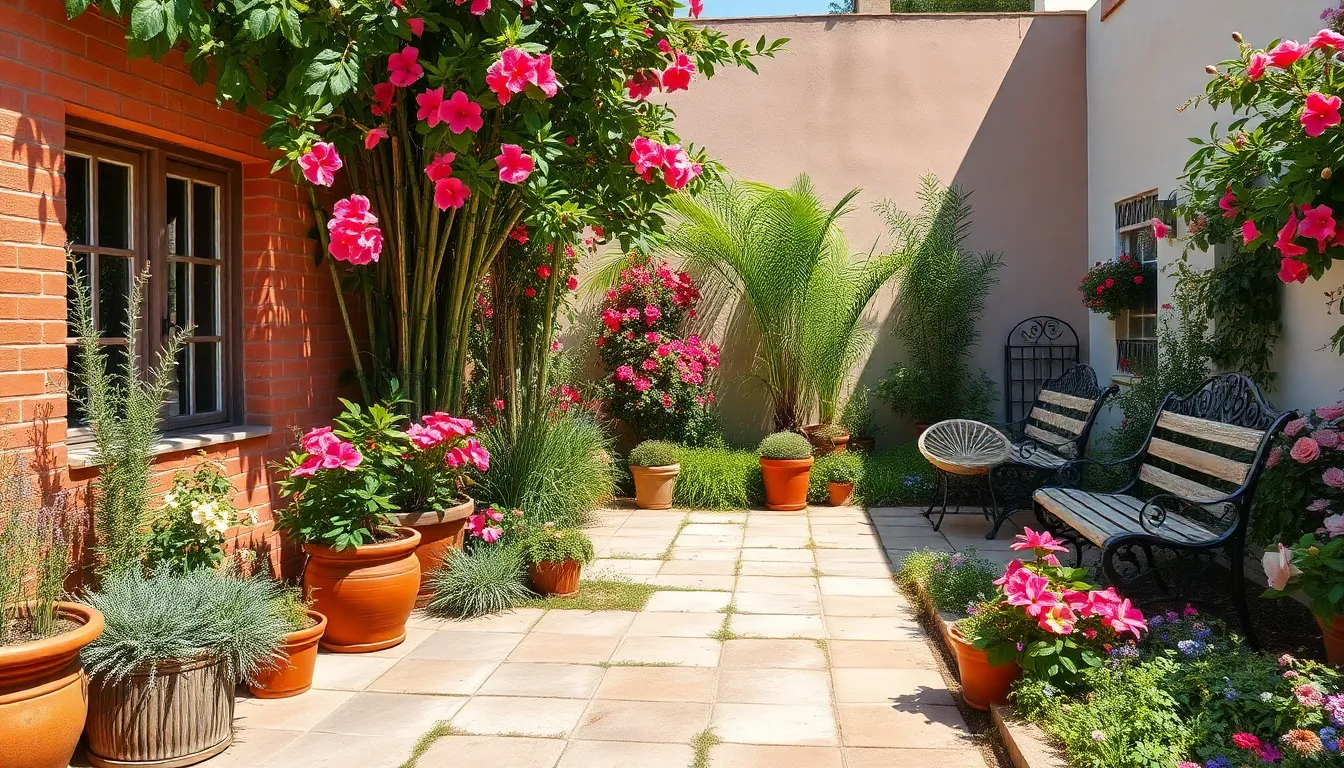
We can transform our patio garden into distinct themed areas that create unique atmospheres and serve different purposes. Each themed section brings its own character while contributing to a cohesive outdoor experience.
Mediterranean Herb Corner
Mediterranean herbs thrive in our patio environment while providing fresh ingredients for cooking. We’ll focus on planting aromatic herbs like rosemary, thyme, and oregano in terracotta pots that complement the warm Mediterranean aesthetic. Terracotta containers offer excellent drainage for these drought-tolerant plants while adding authentic charm to our space.
Stone pathways help define this section and create easy access for harvesting herbs. We can arrange different sized pots along these pathways to create visual interest and maximize our growing space. Adding a small fountain or water feature enhances the Mediterranean ambiance with soothing sounds that make our herb corner a peaceful retreat.
Positioning this section in a sunny spot ensures our herbs receive the 6-8 hours of sunlight they need daily. We can group plants by height and growth habits to create an organized yet natural appearance that’s both functional and beautiful.
Tropical Paradise Zone
Tropical plants bring vibrant colors and exotic appeal to our patio garden space. We’ll select bold specimens like hibiscus and bird of paradise that create dramatic focal points with their striking flowers and foliage. These plants thrive in containers when we provide adequate drainage and regular watering.
Bamboo elements and palm trees add authentic tropical structure to this themed section. We can use bamboo screening to create privacy while reinforcing the tropical atmosphere throughout our space. Natural materials like woven baskets and wooden planters complement the organic tropical aesthetic.
Colorful outdoor furniture becomes part of the design scheme in our tropical zone. We’ll incorporate bright cushions and accessories that echo the vibrant plant colors. Solar-powered lighting extends our enjoyment into evening hours while highlighting the lush tropical foliage after dark.
English Cottage Style Area
English cottage gardens emphasize lush, romantic plantings that create a charming, informal atmosphere. We’ll feature classic plants like English roses, lavender, and wisteria that provide seasonal blooms and delightful fragrances. These traditional cottage garden favorites adapt well to container growing when we select appropriate varieties.
Whimsical garden elements enhance the cottage aesthetic throughout this themed section. We can add vintage-style garden benches and decorative stone pathways that invite quiet contemplation. Weathered containers and antique-inspired accessories contribute to the timeless cottage garden appeal.
Water features like small ponds or fountains complete our English cottage atmosphere. We’ll position these elements to create tranquil sounds that enhance the peaceful garden setting. Climbing plants on trellises add vertical interest while maintaining the cottage garden’s characteristic abundance and charm.
Incorporate Multi-Functional Furniture
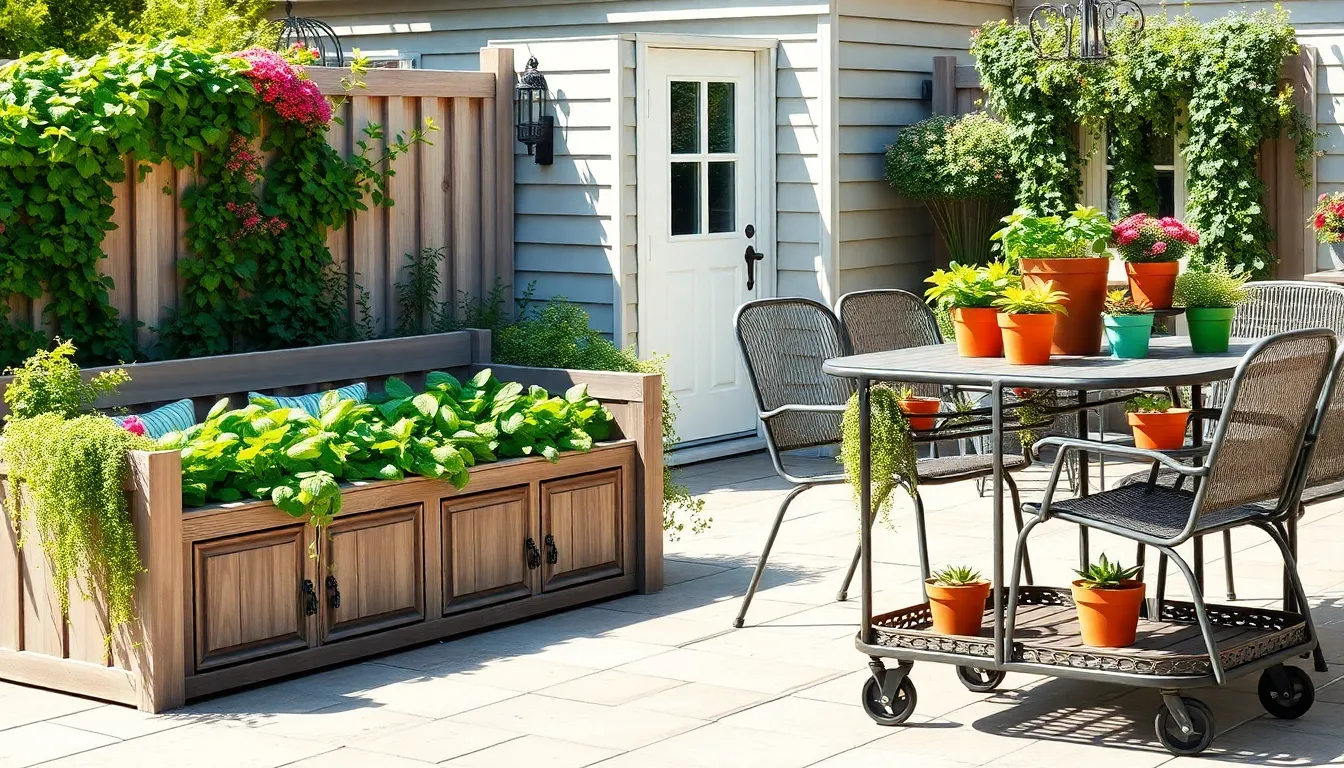
Maximizing our patio garden space becomes effortless when we integrate furniture that serves multiple purposes. Smart furniture choices create functional zones while maintaining our garden’s aesthetic appeal.
Storage Benches With Built-In Planters
Storage benches with built-in planters provide seating while offering space for plants, maximizing patio space usage. These versatile pieces solve two common patio challenges: limited seating and restricted growing areas. We can choose from durable materials like wood or recycled plastic that ensure weather resistance throughout the seasons.
Positioning these benches strategically creates natural room dividers while maintaining open sightlines. The built-in planters work perfectly for herbs, succulents, or trailing flowers that cascade over the edges. We’ll find that the storage compartments underneath accommodate gardening tools, cushions, or seasonal decorations.
Weather-resistant construction ensures our investment lasts through multiple growing seasons. Cedar and teak options offer natural water resistance, while recycled plastic benches provide maintenance-free durability. The planters typically accommodate 6 to 8-inch deep root systems, making them ideal for shallow-rooted plants.
Dining Tables With Herb Gardens
Dining tables with herb gardens incorporate a built-in growing space that allows fresh herbs to be easily accessible during meals. This setup transforms our outdoor dining experience by adding functional greenery directly to our table setup. We can harvest fresh basil, oregano, or cilantro while preparing and serving meals.
Built-in herb gardens add a touch of greenery to our dining area while serving practical purposes. The integrated planters usually run down the center of the table or along one side, creating a living centerpiece that changes with the seasons. We’ll appreciate having cooking herbs within arm’s reach during outdoor meal preparation.
Removable planter inserts make seasonal changes and maintenance simple. Most designs feature waterproof liners that protect the table surface while allowing proper drainage. The herb sections typically measure 4 to 6 inches deep, providing adequate space for most culinary herbs.
Rolling Plant Carts
Rolling plant carts move plants around the patio to optimize sunlight exposure and create ever-changing displays. These mobile answers let us adjust our garden layout based on seasonal sun patterns or special occasions. We can easily relocate heavy planters without lifting or straining.
Ever-changing plant displays become possible when we use wheeled carts to rearrange our garden setup. The mobility allows us to create focal points for parties, move shade-loving plants during hot afternoons, or bring tender plants closer to shelter during storms. Multi-tiered carts maximize vertical growing space while maintaining portability.
Sturdy construction with locking wheels ensures stability when the cart reaches its destination. Most rolling carts feature powder-coated metal frames or weather-treated wood that withstand outdoor conditions. The wheels typically measure 4 to 6 inches in diameter for smooth movement across various patio surfaces.
Add Water Features and Focal Points
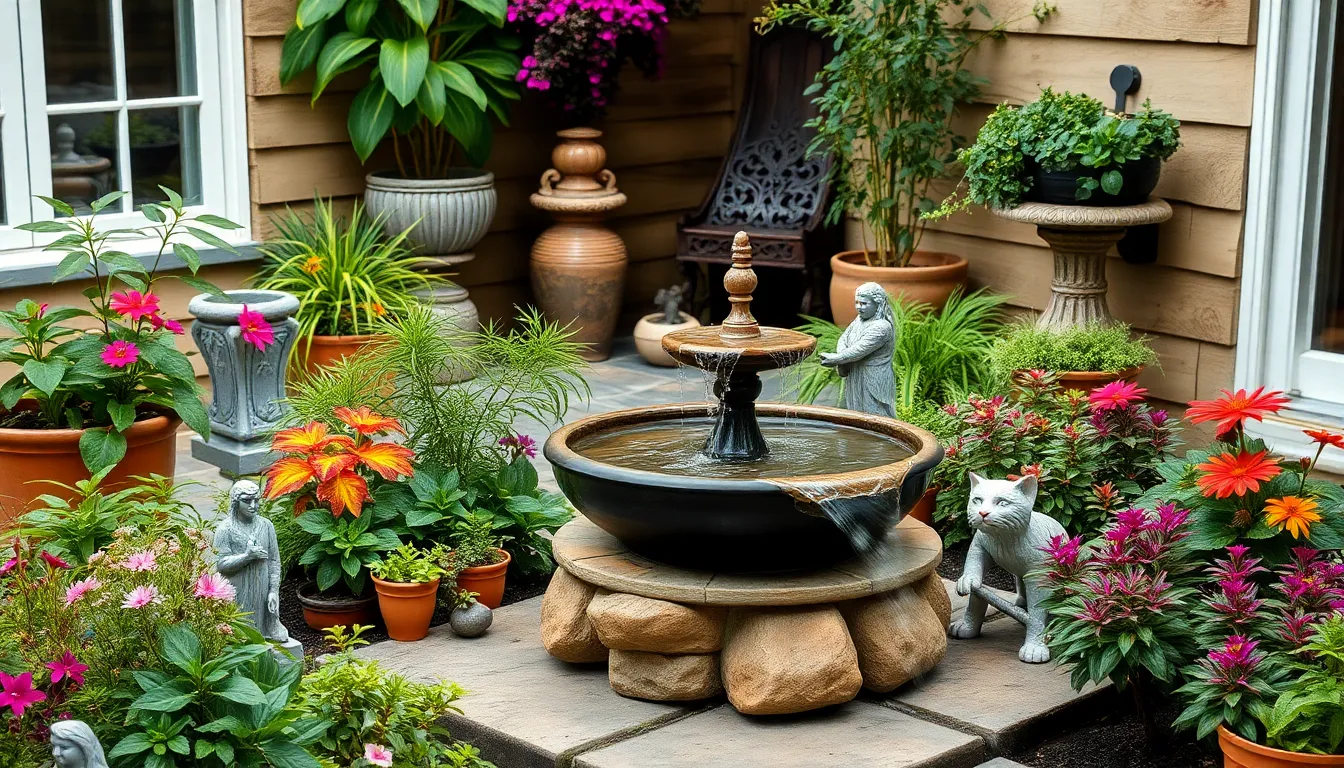
Water elements and eye-catching sculptures transform ordinary patio gardens into extraordinary retreats. These additions create sensory experiences that elevate your outdoor space beyond simple plant arrangements.
Tabletop Fountains
Small fountains work perfectly for intimate patio settings where space comes at a premium. These self-contained units rest comfortably on side tables, dining surfaces, or plant stands without requiring permanent installation. Most tabletop models measure between 8 to 18 inches in height and operate with simple plug-in electrical connections.
Sound becomes a crucial design element when selecting these compact water features. Gentle trickling creates a peaceful atmosphere that masks urban noise like traffic or neighbor conversations. Battery-powered options offer flexibility for patios without nearby electrical outlets, typically running 6 to 8 hours on a single charge.
Material choices affect both durability and aesthetic appeal for outdoor fountain displays. Ceramic and stone models complement Mediterranean herb corners beautifully, while metal versions suit modern container arrangements. Resin fountains resist weather damage better than natural materials and weigh significantly less for easy seasonal repositioning.
Rain Chain Installations
Rain chains replace traditional downspouts with decorative water management that doubles as garden art. These Japanese-inspired installations guide rainwater from gutters to ground level through linked cups, bells, or geometric shapes. Copper varieties develop attractive patina over time, while aluminum options maintain consistent appearance.
Musical qualities emerge when rainwater flows through properly designed chain systems. Different cup shapes and spacing create unique sounds during precipitation, from gentle chimes to robust gurgling effects. Installation requires simple gutter modification and positioning collection vessels at ground level.
Creative arrangements extend beyond basic downspout replacement for enhanced visual impact. We’ve seen successful installations where chains direct water into rain barrels, decorative basins, or existing pond features. Multiple chains can create cascading effects along covered patio edges or pergola structures.
Decorative Garden Sculptures
Strategic sculpture placement creates natural gathering points that anchor your patio garden design. These focal elements work best when positioned to complement existing container arrangements rather than compete with plant displays. Abstract pieces suit modern vertical gardens, while classical statues enhance English cottage style areas.
Scale considerations ensure sculptures integrate harmoniously with surrounding plant heights and container sizes. Pieces measuring 18 to 36 inches tall work well for most patio proportions without overwhelming compact spaces. Larger sculptures exceeding 48 inches require substantial areas and strong visual balance through surrounding plantings.
Weather-resistant materials protect sculpture investments while maintaining aesthetic appeal year-round. Bronze and powder-coated metal pieces withstand temperature fluctuations better than painted surfaces. Stone and ceramic options suit Mediterranean themes but require winter protection in freezing climates. Resin alternatives offer lightweight durability with realistic finishes that mimic expensive materials.
Choose Low-Maintenance Plant Varieties
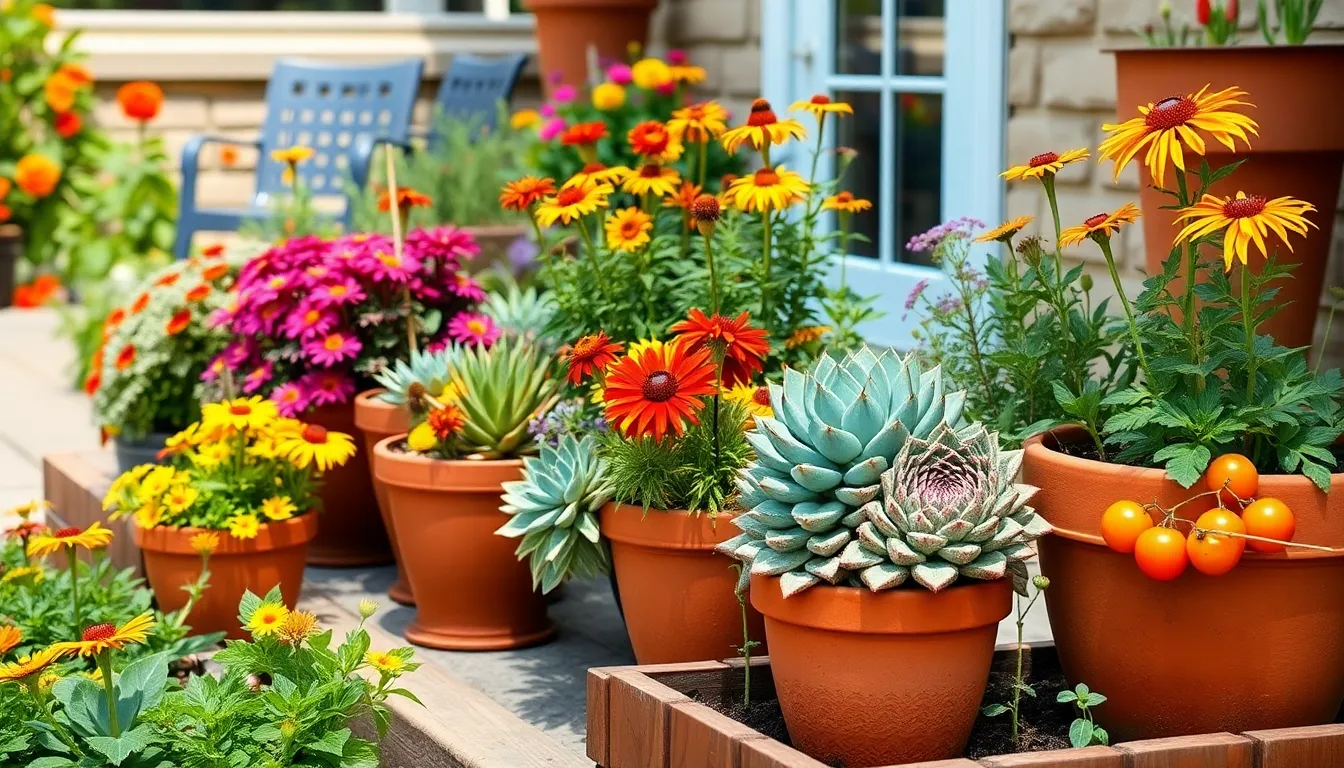
After establishing your patio garden’s foundation with containers and design elements, selecting the right plants becomes crucial for long-term success. We recommend focusing on varieties that thrive with minimal intervention while still delivering maximum visual impact.
Drought-Tolerant Succulents
Succulents represent some of the most resilient plants for patio gardens, requiring minimal water while offering stunning visual appeal. Echeveria, Agave, and Sedum stand out as particularly hardy choices that can withstand neglect while maintaining their colorful appearance throughout the seasons.
These plants excel in sunny locations where other varieties might struggle, making them perfect for south-facing patios or areas with intense afternoon sun. Good drainage becomes essential for succulent success, so we always recommend using porous, well-aerated soil mixtures that prevent root rot.
Raised beds work exceptionally well for succulent displays, allowing excess water to drain away quickly while creating an attractive elevated garden feature. Terra-cotta containers also provide excellent drainage properties while complementing the natural colors of most succulent varieties.
Perennial Flowering Plants
Perennial flowers offer the perfect balance between beauty and practicality, returning year after year without replanting. Powerhouse perennials like coneflowers, black-eyed Susans, and ornamental grasses provide continuous color while requiring minimal maintenance once established.
We suggest focusing on just a few high-impact varieties rather than many different types, creating bold displays that make strong visual statements. Multi-colored arrangements work particularly well in terra-cotta planters, where contrasting flower colors can create vibrant focal points without requiring large growing areas.
Native perennial selections prove especially valuable since they’re naturally adapted to local conditions, reducing the need for fertilizers and pest control interventions. These plants typically establish deeper root systems that help them survive drought conditions and temperature fluctuations.
Easy-Care Vegetable Options
Container vegetable gardening transforms food production into a manageable patio activity that fits any lifestyle. Container growing allows us to control soil quality, drainage, and plant spacing while keeping maintenance tasks at a comfortable height for easy access.
Wheelbarrow gardens offer a creative solution for mobile vegetable production, requiring only simple drainage holes drilled into the bottom for proper water management. This approach lets us move plants to follow sunlight patterns or protect them from harsh weather conditions.
Leafy greens, herbs, and compact tomato varieties thrive in container environments while providing fresh ingredients for daily cooking. These crops typically require less space than traditional garden vegetables while offering higher yields per square foot, making them ideal choices for space-conscious patio gardeners.
Install Proper Lighting Solutions
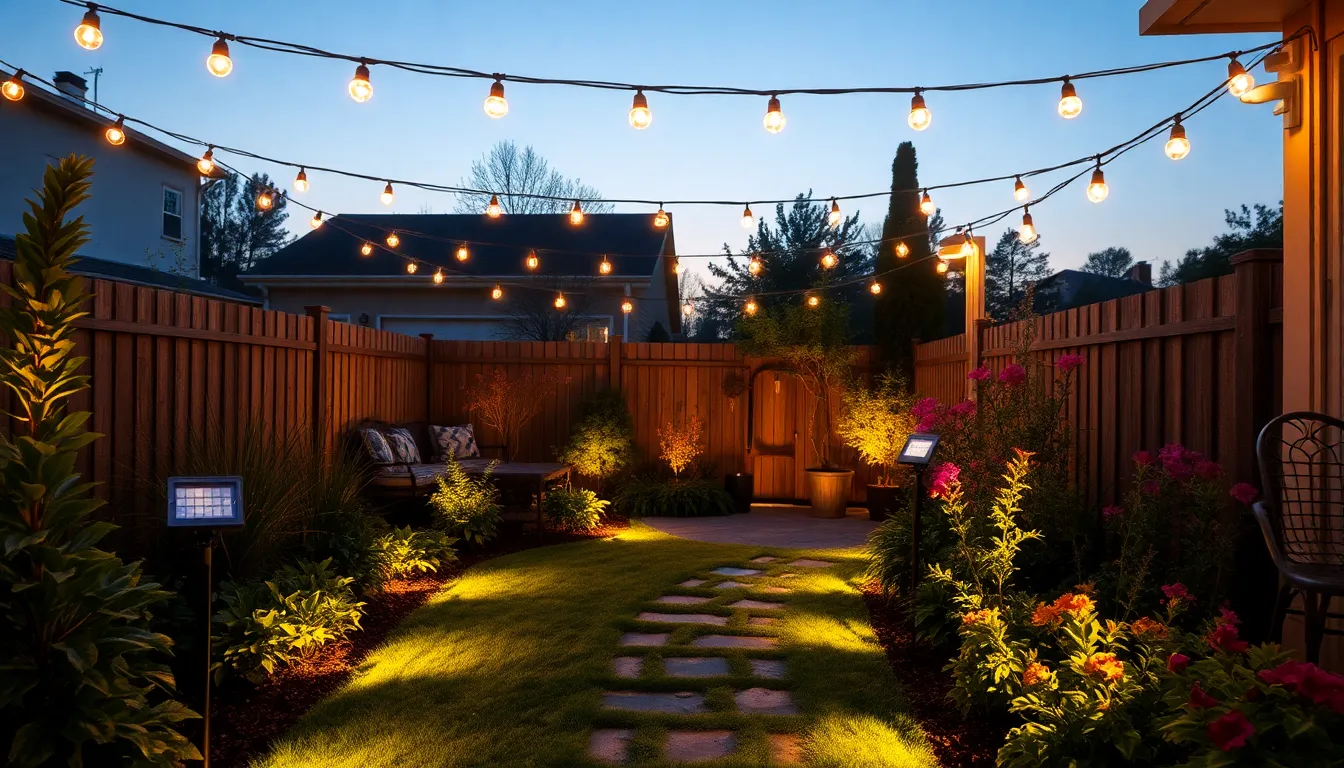
Transform your patio garden into a magical evening retreat with strategic lighting that enhances both safety and beauty. We’ll explore three essential lighting approaches that create stunning nighttime displays while keeping your outdoor space functional after dark.
Solar-Powered Path Lights
Solar powered path lights deliver energy efficient illumination that requires zero electricity costs while protecting the environment. These eco friendly fixtures automatically charge during daylight hours and provide gentle ambient lighting for 6 to 8 hours each evening. We recommend positioning them every 6 to 8 feet along walkways and garden borders to create clear navigation paths through your patio garden.
Installation becomes effortless since solar lights need no wiring or electrical connections. Most models feature ground stakes that push directly into soil or weighted bases for hard surfaces. Choose lights with LED bulbs that last up to 50,000 hours and withstand outdoor weather conditions year round.
String Lights for Ambiance
String lights create warm and cozy atmospheres that transform ordinary patio spaces into enchanting outdoor rooms. We suggest hanging them in zigzag patterns across your patio ceiling or wrapping them around pergola posts and railings for maximum visual impact. Edison bulb styles provide vintage charm while LED options offer energy savings up to 80% compared to traditional incandescent bulbs.
Battery powered string lights offer flexible placement options without electrical outlet limitations. Solar string light versions charge automatically and illuminate for 8 to 10 hours per night depending on daily sun exposure. Consider dimmer compatible models that adjust brightness levels for different occasions and moods.
Spotlights for Featured Plants
Spotlights highlight your most beautiful plants and garden features while adding dramatic visual depth to nighttime patio displays. We recommend installing adjustable LED spotlights that direct concentrated beams onto specimen trees, flowering shrubs, or sculptural elements. Position lights at ground level pointing upward to create striking shadow patterns against walls and fences.
Choose spotlights with narrow beam angles between 15 to 30 degrees for precise plant highlighting versus wide flood patterns. Solar spotlight models eliminate wiring requirements while providing 4 to 6 hours of focused illumination per charge. Install multiple spotlights throughout your patio garden to create layered lighting effects that showcase different plants and design elements.
Maximize Small Space Efficiency
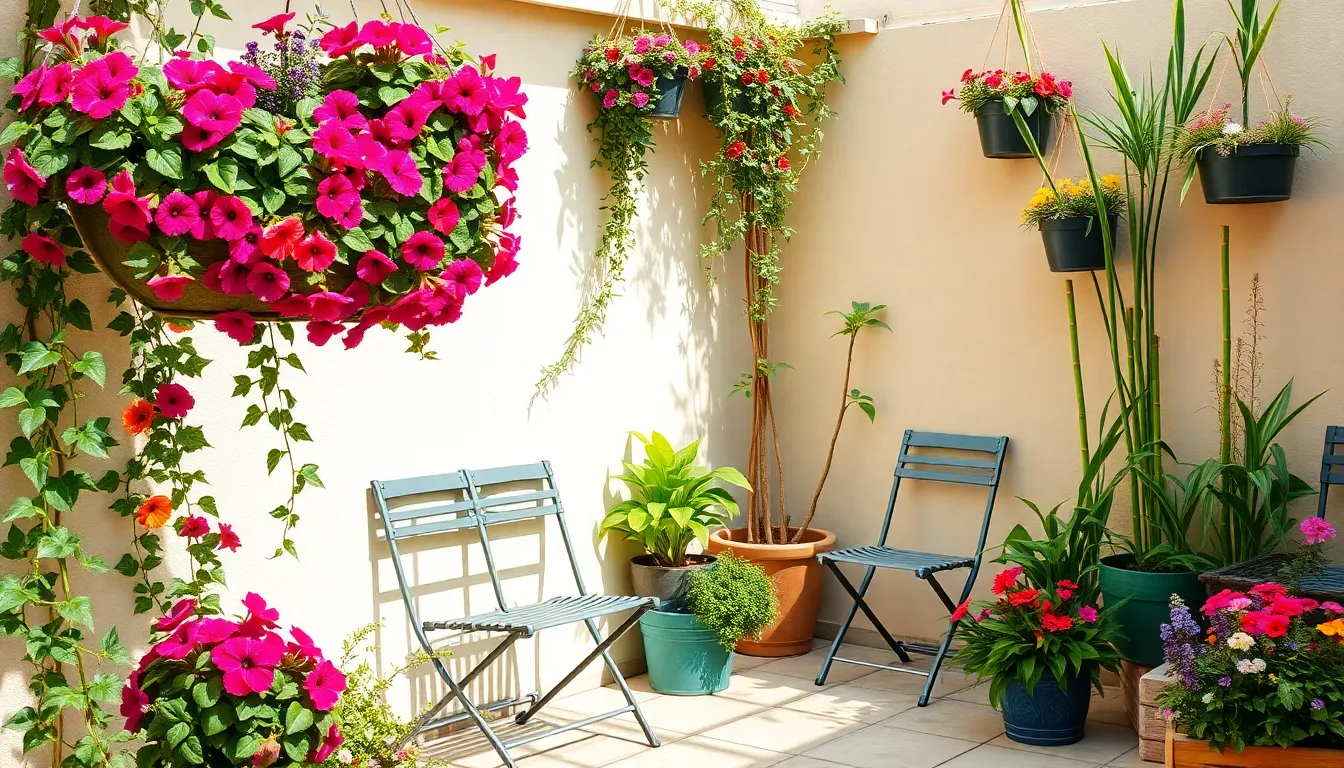
Making the most of limited patio space requires strategic planning and creative answers that transform every square inch into productive growing areas.
Hanging Basket Arrangements
Hanging baskets create vertical growing opportunities while freeing up valuable floor space for larger containers or furniture. We recommend positioning bright flowering plants like petunias, impatiens, and begonias at eye level where they’ll receive adequate light and remain easily accessible for watering. Cascading plants such as trailing nasturtiums, ivy, and bacopa spill gracefully downward to create lush curtains of foliage without occupying ground space.
Multiple baskets arranged at varying heights add visual depth and dimension to your patio garden design. Consider installing pulley systems or adjustable hangers to lower baskets for maintenance tasks like deadheading and fertilizing. Mixed plantings combining upright varieties with trailing specimens in the same basket maximize bloom coverage and create fuller displays throughout the growing season.
Corner Plant Groupings
Corner spaces often remain underutilized in patio designs, yet they offer excellent opportunities for creating focal plant displays. We suggest grouping plants with different textures and heights in corner arrangements to maximize visual interest while efficiently using space. Tall plants like bamboo or ornamental grasses can anchor the back corners, with medium height flowering perennials in the middle, and low growing groundcovers or trailing plants in front.
Vertical support structures like obelisks or trellises installed in corners allow climbing plants to grow upward rather than spreading outward across the patio floor. Corner planters designed specifically for these spaces often feature triangular shapes that fit snugly into tight areas while providing ample root space for plant growth.
Foldable Garden Furniture
Space saving furniture pieces that fold flat when not in use allow us to maximize plant growing areas while maintaining functional seating and dining options. Foldable chairs, tables, and benches can be quickly stored against walls or in compact storage areas during peak growing seasons when more floor space is needed for containers.
Compact furniture designs with built-in storage compartments serve dual purposes by housing gardening tools, potting supplies, or seasonal decorations. We recommend selecting furniture with sleek profiles and neutral colors that complement rather than compete with plant displays for visual attention. Built-in planters integrated into bench designs create additional growing space while providing comfortable seating areas for enjoying your patio garden.
Create Seasonal Interest Elements
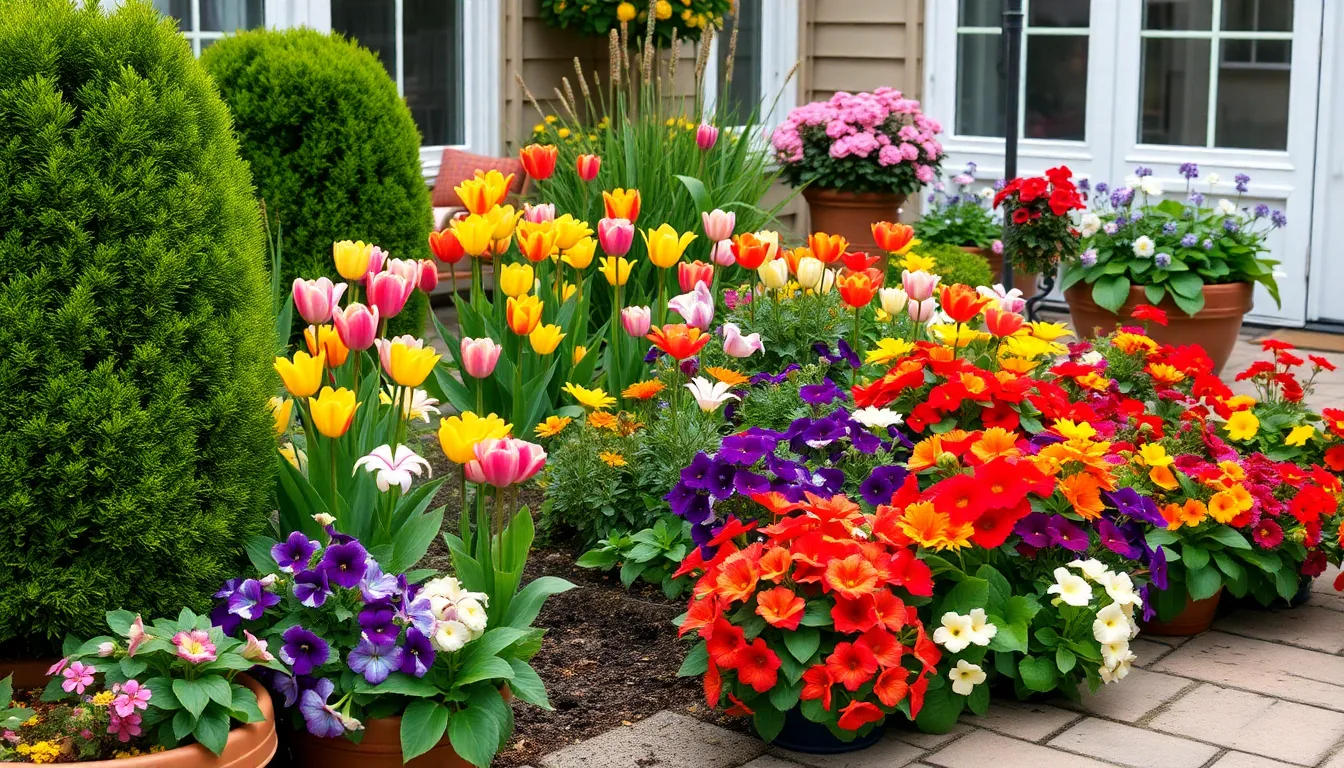
We’ll keep our patio garden vibrant throughout the year by incorporating plants that deliver stunning displays across all seasons. Strategic seasonal planning ensures continuous color and texture changes that make our outdoor space feel fresh and ever-changing.
Spring Bulb Displays
Tulips create spectacular early spring color when planted in clusters throughout our patio containers. We can plant these bulbs in fall for a rewarding display that emerges just as winter fades. Daffodils provide cheerful yellow blooms that naturalize beautifully in larger containers, while hyacinths add intense fragrance to our morning coffee ritual.
Pansies offer immediate spring color for those who prefer instant gratification over bulb planning. These hardy flowers thrive in cooler spring temperatures and provide vibrant faces in purple, yellow, and orange. Violas complement pansies perfectly with their smaller blooms and extended flowering period that bridges the gap between early spring bulbs and summer annuals.
Summer Flower Rotations
Petunias deliver continuous summer blooms when we deadhead spent flowers regularly and provide consistent moisture. These annuals thrive in hanging baskets and containers, creating cascading displays in vibrant colors. Marigolds complement petunias with their pest-repelling properties and bold orange and yellow blooms that last until frost.
Coneflowers establish perennial beauty that returns stronger each year with minimal maintenance. We can plant these native perennials in larger containers where they’ll attract butterflies and provide seed heads for winter interest. Container rotation allows us to move flowering displays to prominent positions during peak bloom times, then relocate them as other plants take center stage.
Fall and Winter Evergreens
Boxwood provides year-round structure that anchors our patio garden design through every season. We can trim these evergreen shrubs into formal shapes or allow natural growth for a relaxed cottage garden feel. Holly varieties add seasonal berries that brighten winter days while maintaining their glossy green foliage.
Winterberry holly creates stunning winter displays with bright red berries that persist after leaves drop. These deciduous shrubs complement evergreen companions and provide food for winter birds. Hellebores emerge as true winter champions, producing elegant blooms in white, pink, and purple during the coldest months when most plants remain dormant.
Conclusion
Your patio garden dreams can become reality with the right combination of strategic planning and creative execution. We’ve shown you how to transform any outdoor space into a thriving green sanctuary through smart container choices vertical growing answers and themed design approaches.
The key lies in maximizing every square inch while maintaining both beauty and functionality. From multi-purpose furniture to seasonal plant rotations these techniques ensure your patio garden remains vibrant year-round without overwhelming your space or schedule.
Remember that successful patio gardening isn’t about perfection—it’s about creating an outdoor retreat that brings you joy. Start with one or two ideas that resonate most with your vision and gradually expand as your confidence grows. Your personalized patio paradise awaits!
Frequently Asked Questions
What container size do I need for different patio garden plants?
For herbs, use containers at least 12 inches deep. Tomatoes and peppers require 18-24 inch deep pots for proper root development. Larger containers retain moisture better and provide adequate space for healthy plant growth. Always ensure containers have proper drainage holes to prevent root rot.
How can I maximize space in a small patio garden?
Use vertical gardening techniques like wall-mounted planters and trellises for climbing plants. Install tiered plant stands to create multiple growing levels. Consider hanging baskets to free up floor space and utilize corner areas for plant groupings. Foldable furniture also saves space while maintaining functionality.
What are the best low-maintenance plants for patio gardens?
Drought-tolerant succulents like Echeveria and Agave require minimal water and thrive in sunny locations. Perennial flowers such as coneflowers and black-eyed Susans return yearly with little care. Native plants typically need less fertilizer and pest control, making them ideal for busy gardeners.
How do I create themed areas in my patio garden?
Design distinct zones like a Mediterranean herb corner with terracotta pots, a tropical paradise with hibiscus and bird of paradise, or an English cottage style area with roses and lavender. Use complementary containers, pathways, and decorative elements to create cohesive themed spaces.
What lighting options work best for patio gardens?
Solar-powered path lights provide energy-efficient navigation and safety. String lights create cozy evening atmospheres perfect for relaxation. Spotlights highlight beautiful plants and garden features, transforming your patio into a magical nighttime retreat while maintaining functionality after dark.
How can I incorporate water features into my patio garden?
Tabletop fountains are compact options that create peaceful atmospheres without taking up floor space. Rain chains serve as artistic water management solutions while adding visual interest. Position water features strategically as focal points to enhance the sensory experience of your garden.
What multi-functional furniture works well in patio gardens?
Storage benches with built-in planters provide seating and growing space simultaneously. Dining tables with integrated herb gardens offer fresh ingredients during meals. Rolling plant carts allow flexible arrangements based on sunlight needs and seasonal changes while maximizing limited space.
How do I maintain seasonal interest in my patio garden?
Plant spring bulbs like tulips and daffodils for early color, followed by pansies for immediate blooms. Rotate summer flowers like petunias and marigolds for continuous color. Include evergreens such as boxwood and winterberry holly to maintain structure and visual appeal during fall and winter months.

